Menu
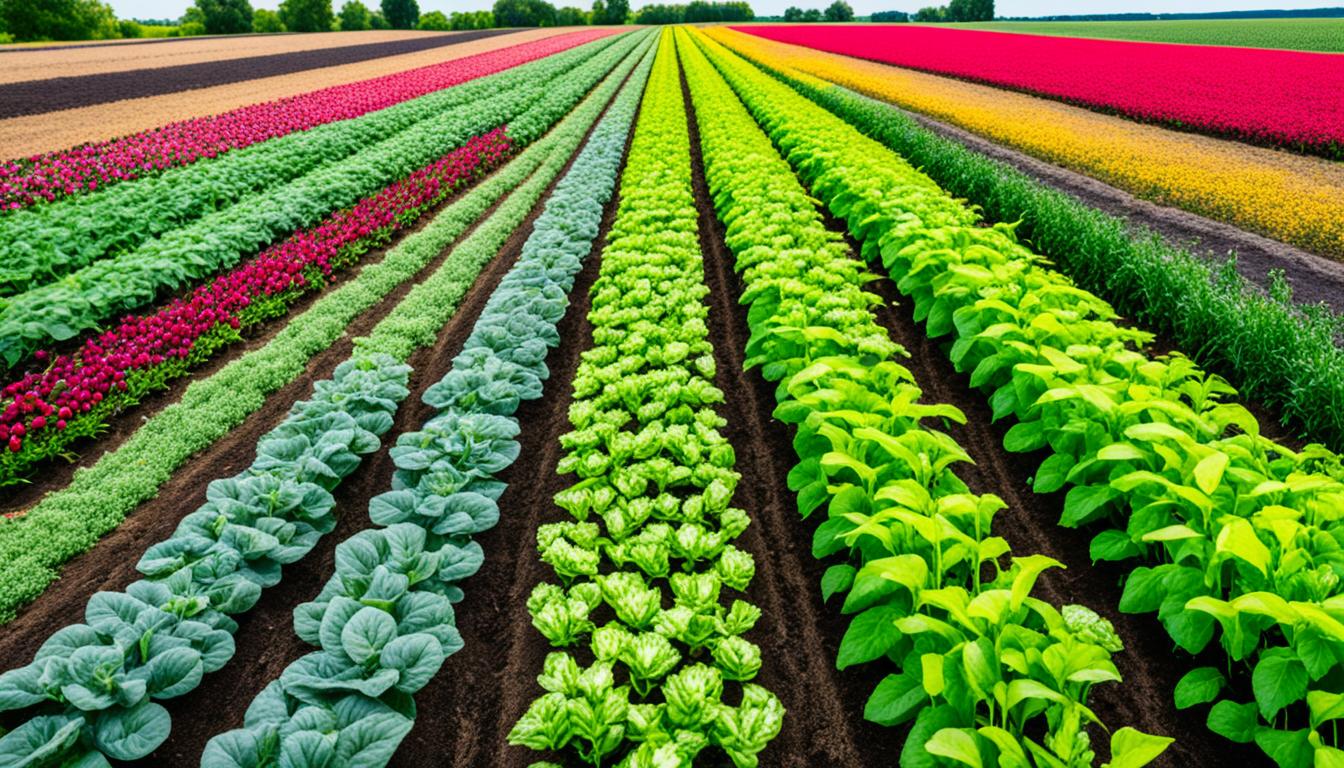
Turning dry lands into lively ecosystems is tough but worth it. I remember the spot in California’s Central Coast that was barren. Now, with sustainable farming and a lot of biodiversity, it’s filled with life. Seeing many plants, busy soil, and pollinators shows how vital biodiversity is for farms.
Big farms have focused on being the same and making a lot of crops. But this approach has made it hard for nature to thrive. Tallgrass areas have shrunk a lot, with most changes due to turning lands into farms. Sadly, 80 percent of deforestation globally is because of farming. The impact is huge, like how monarch butterflies are facing a big decrease because their homes are disappearing.
Yet, we can change this path by welcoming more plants and animals onto our farms. Such moves make our farm systems stronger and able to produce more food. It’s not just about helping with bugs and making sure plants get pollinated. Biodiversity also helps farms deal with climate changes.
The latest findings tell us that farming more gently helps more life to grow. These ways are different for each place but all help create varied habitats. Together, they make our farms more lasting and better for nature.
Taking a moment to think about these facts makes it clear. We must add biodiversity to our farms to make them last and be strong against change.
Looking into biodiversity in agricultural systems shows us the benefits. Practices like cover cropping and composting help both the economy and the environment. They make farms stronger against diseases and tough weather. For example, using crop leftovers as mulch increases life and variety in farming. This way of adding different plants and animals to a farm is key to making it last.
Small areas like riverbanks and forests around farms are very important. They help crops grow better by aiding in things like pollination. This is crucial for healthy agroecosystems to operate well.
Having many types of plants and animals on a farm meets what people want to eat. It gives more nutrition than farms growing just one type of thing. Also, the variety of life here creates homes for insects that help plants grow and kill harmful bugs. Growing crops that come back every year is also vital. Even though they don’t make as much money as those planted every year, they keep the land healthy and stop it from washing away.
The Convention on Biological Diversity has 12 rules to look after nature. It says that we should let nature take its course, while also using it wisely. This helps keep the essential things nature does for us going.
| Biodiversity Strategies | Impact |
|---|---|
| Integrating Planned Biodiversity | Sustainable Crop Production |
| Maintaining Mulch Covers | Increased Biological Activity & Diversity |
| Fragmented Land Areas | Enhanced Agricultural Yield |
Talking to others and keeping up with efforts to save nature is really important. And, all groups who try to do this need to work together. This makes sure they have the same clear goals and dreams.
More crop types on farms help boost on-farm life variety. This, in turn, brings gains for the environment and the pocket. Many farmers, though, find it hard to break into diversified farming, especially those with less to spend. The genetic mix of crops is key for keeping harvests high in different farm settings. It is the bedrock of farm resilience.
Growing different types of crops does wonders for farms. It helps the soil thrive, cuts down on chemicals, and makes the farm’s natural processes more tough. A mixed crop field is likely to host a rich variety of tiny life and helpful bugs. Soils in mixed crop fields are also more stable.
Techniques like growing different plants together and changing where crops go every season help with bugs and diseases. Take growing beans and other plants together, for example. They boost the number of beans in almost half the cases tried. Practices like these not only up harvests but also help fight climate change and save money.
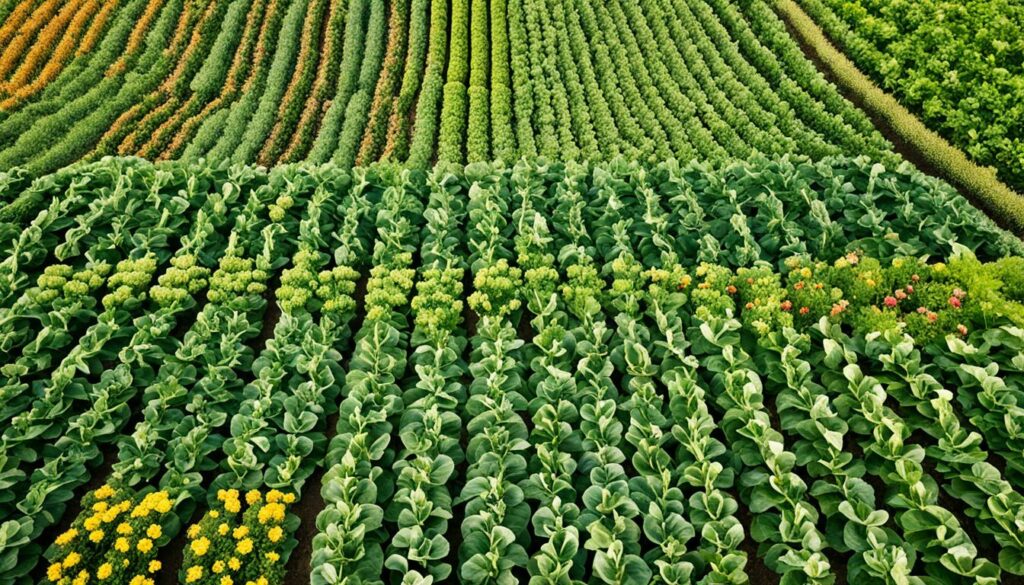
New stories show how mixing up crops in farms can make a big difference:
In a 2022 study, Schoolmaster Jr. et al. found the right mix of species is what boosts farm performance, not just how many kinds are out there. This makes choosing and looking after crops key.
Swapping crops around does a great job at keeping bugs and sickness away. The trick seems to be in the plant swap rather than just having a lot of different plants. Surprisingly, research by Köninger et al. (2023) and Labouyrie et al. (2023) suggests farm soils can actually be teeming with more life than forests and wild fields. This was a shock to many.
| Intercropping Strategy | Success Rate (%) |
|---|---|
| Legumes + Non-Legumes | 43.8 |
| Relay Crops | 43.8 |
Altogether, these studies and numbers support the idea that mixing up crops can make farms better. The real trick, though, is using the right techniques to get the most out of them.
Sustainable agriculture practices are vital for tackling economic and food safety issues. They help promote on-farm biodiversity and resilience. These methods include using renewable energy, reducing waste, and improving soil health.
Cover cropping is one key approach. It involves planting specific crops in the off-season. This reduces the need for fertilisers, cutting costs for farmers. Cover crops improve soil health and help nature flourish. They shield the soil, stopping erosion and improving how it holds water. This means farmers might use 20-40% less water for irrigation.
Composting is another crucial aspect of sustainable farming. It turns waste into nutrition for the soil. This enriches the ground, helping crops grow strong. Composting also cuts the need for harmful chemicals and supports tough plant varieties. Techniques like permaculture and no-tillage farming are also key. They prevent soil erosion and reduce pollution.
The use of Integrated Pest Management (IPM) and biological control is a great example of replacing toxic pesticides. For instance, farmers might use ladybirds to keep pests in check. There are also eco-friendly ways to deal with weeds, like pulling them out by hand. These methods aim to keep the ecosystem balanced without polluting it.
Overall, sustainable farming cuts costs, boosts soil and biodiversity. It ensures farms keep producing without harming the environment. It supports farmers both ecologically and economically.
| Practices | Benefits |
|---|---|
| Cover Cropping | Reduces fertiliser costs, enhances soil health, conserves water |
| Composting | Enriches soil fertility, reduces chemical inputs, supports resilient crop types |
| No-Tillage | Lessens soil erosion, cuts fossil fuel emissions |
| IPM | Controls pests biologically, reduces reliance on chemical pesticides |
It’s key to know the role of agroecosystems in farming. They help crops grow sustainably. Across the globe, farmers use methods that promote plant and animal variety. This variety helps with growing food. It also gives us natural help, like bug control and making sure plants get fertilised.
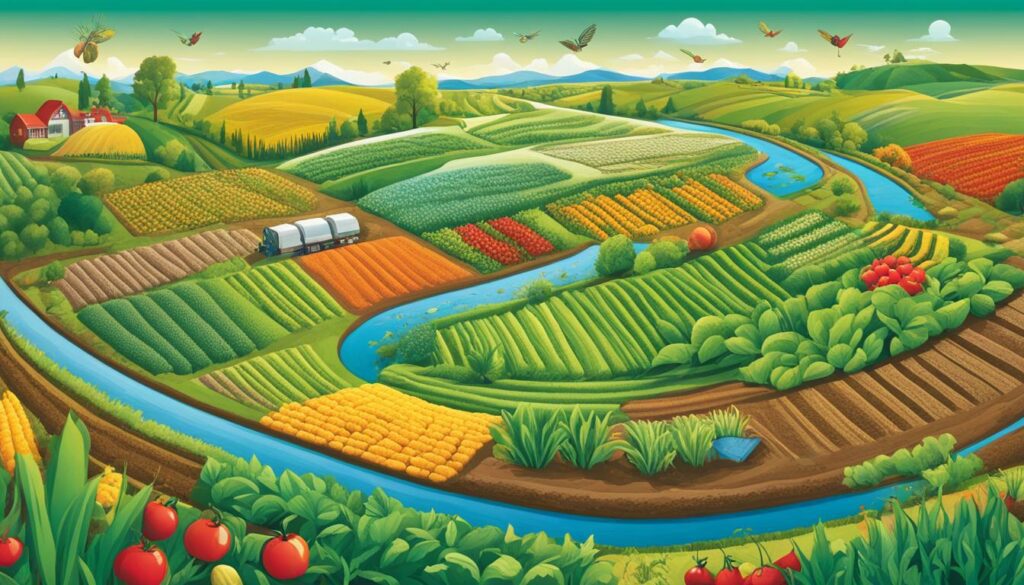
Agroecosystems are about lots of different plants, animals, and tiny living things all working together. They play a big role in moving energy, water, and nutrients around. When farms have lots of different life forms, they work better. This makes them more able to bounce back from problems and produce more.
Agroecology wants to find the sweet spot between using land for food and keeping the land healthy. This balance really matters. Without enough variety on our farms, it becomes harder to grow food. We would also have to spend more money and harm the environment to do so. This happens because we’d need more chemicals and other outside products to keep things going.
Nowadays, farms tend to focus on just a few types of plants and animals. But it’s time we rethink this strategy. We should focus on how different living things help each other. This helps the whole system to work better.
Looking at how agroecosystems compare helps us understand why diversity is so important:
| Ecosystem Function | Traditional Agriculture | Intensive Agriculture |
|---|---|---|
| Species Diversity | High | Low |
| Energy Movement | Efficient nutrient cycling | Requires external inputs |
| Soil Health | Stable and resilient | Prone to erosion |
| Pest Management | Biological control mechanisms | Pesticide reliant |
We must value the role of agroecosystems. This means using and creating more agroecological technologies. They’re all about saving nature and resources. That way, we can keep farming in ways that are good for the planet and the people who come after us.
To protect biodiversity, many strategies are being used worldwide. One key focus is saving certain species. This is vital, as they help keep the ecosystem in balance. Protecting key species helps make the ecosystem stronger and more stable.
Habitat conservation is another big strategy. It aims to save whole ecosystems. By looking after biodiversity hotspots, we help protect places rich in diverse plants and animals. This way, every part of the ecosystem gets care.
Getting involved with global biodiversity meetings also helps. This links efforts across the world for better habitat and species protection. It makes conservation plans work better together, making their impact stronger.
Improving farming methods to include more biodiversity helps too. Using crops that last a long time can help fight pests without harming the land. This method also supports the health of the wider ecosystem.
Government policies are also vital. Encouraging farmers to protect habitats and species can be very effective. For example, saving different crop types helps in producing food better. It also fits different farming conditions well.
Stressing continual conservation works better than short-term efforts. Planning biodiversity efforts carefully and working with the whole ecosystem helps a lot. This approach makes sure our efforts are lasting, united, and successful in saving Earth’s biodiversity.
A teaspoon of topsoil has roughly 6 billion microorganisms, showing rich diversity in the soil microbiome. This diversity is key to making soil healthier and growing more crops. Organic farming helps by using a variety of life forms to boost soil and farm success. According to the Food and Agriculture Organization (FAO), soil biodiversity is worth over US$154.2 billion. It’s essential for farming that is good for the environment and the future.
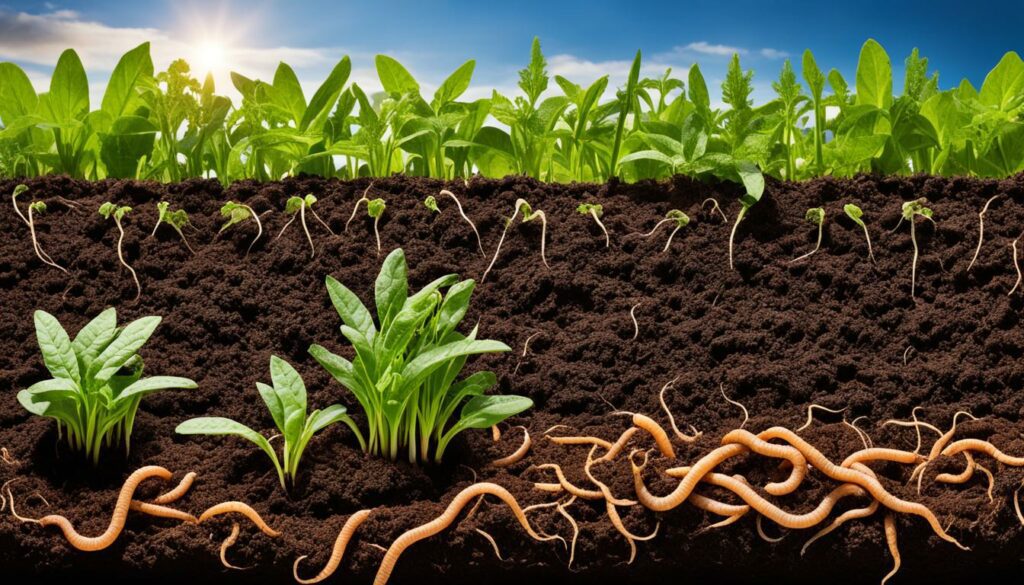
Keeping the soil microbiome healthy is important for getting lots of crops. Farming methods like changing crops each year, not digging the soil too much, and adding natural materials help the soil bugs and plants work well together. This cuts down on harmful bugs and diseases, and helps plants use food better. More types of plants also mean more life in the soil, which makes farms stronger and more fruitful.
Organic farming helps a lot in growing a good soil microbiome and healthy soil. Things like covering the soil and not disturbing it make a great home for tiny life. Infusing the soil with organic materials makes big and little creatures, like earthworms, happy. They help keep the soil in good shape and are a sign of a balanced system. Growing crops in ways that keep the soil healthy uses water better and doesn’t rely so much on things that aren’t from nature. This makes farming better for the land and us.
Using these organic methods is a big step towards saving soil life and producing more. Knowing how different plants and bugs help the soil is vital. It means we can farm in a way that lasts a long time and is good for all.
Biodiversity is key in making our farms more resilient to climate change. Mixing different species on farms boosts important jobs like pollination and keeping pests in check. This helps us adjust to the changing climate and lower risks.
The growth of agriculture has caused big losses in biodiversity around the world. This happens as habitats are changed, and pollution and soil damage increases. The problem gets worse as more land is cleared for farms, putting many plants and animals at risk of disappearing.
Moving towards growing only one crop, known as monoculture, reduces the natural variety in our farms. But, research shows that having many different plants helps with pollination, reduces pests, and makes the soil better. This link between many plants and better farming shows why adapting to climate changes is so important.
On a wider scale, planting a bigger mix of crops can make our food supplies safer and steadier. This balances out how much food we get in different weather. With a warning that Africa may see a drop of more than 30% in food grown by 2050 because of climate change, protecting the many types of plants is crucial. This helps keep food coming while looking after the land.
| Issue | Impact | Solution |
|---|---|---|
| Loss of biodiversity | Habitat conversion and pollution | Sustainable forest management, land restoration |
| Land clearing | Extinction risk for species | Community-based biodiversity conservation |
| Crop monocultures | Reduced ecosystem diversity | Increased crop diversity |
To keep biodiversity safe and fight against the changing climate, we should work on wasting less food, using different plant types, and learning from traditional ways of farming. Tackling these problems in a big way can make farming more lasting and ready for what the future brings.
Agriculture is changing, putting more focus on keeping a variety of crops. This is done through ecological intensification and regenerative agriculture. The FAO’s report shows a big decrease in plant and crop diversity. This is bad for fighting climate change.
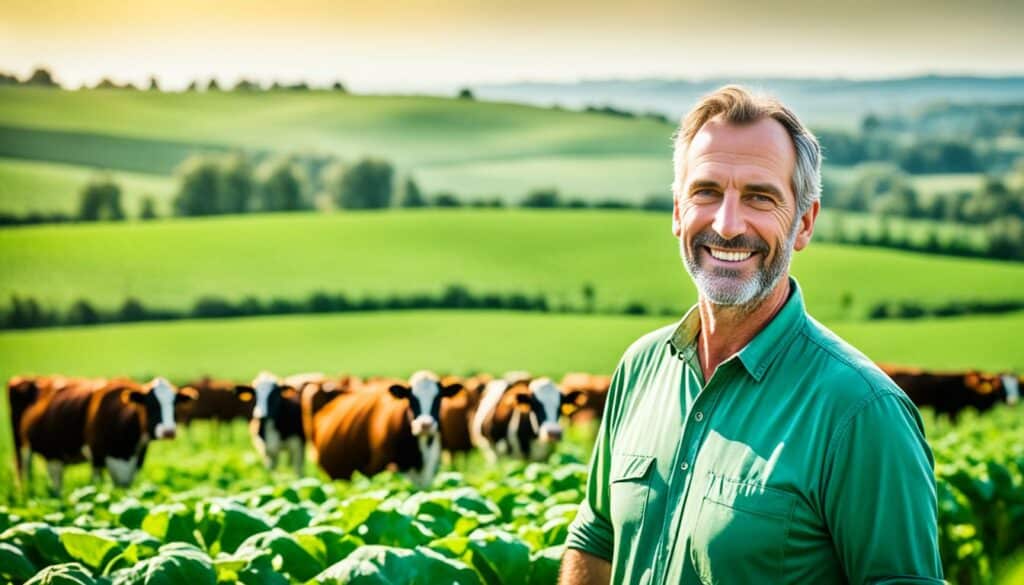
Balancing soil life is key to better nutrients in the land. This helps the soil get more minerals and enzymes. It also fights off plant diseases, makes nutrients easier for plants to use, and supports plants against pests.
Using high-tech sensors and data tools in farming helps check soil health and grow better crops. Scientists are looking at how different plants and tiny soil life interact. They want to see how this helps manage pests without harmful chemicals.
But, getting better soil health needs everyone who’s interested to work together. This includes farmers, researchers, and policy makers. They all need to work towards farming that’s good for the environment and the crops.
| Aspect | Key Insights |
|---|---|
| Nutrient Cycling | Improves soil mineral and enzyme content |
| Pathogen Control | Enhances control of soil-borne pathogens |
| Pest Resistance | Increases resistance in plants |
| Data Analytics | Tracks microbial populations and soil quality |
| Multi-sectoral Approach | Engages stakeholders for long-term solutions |
Government policies are vital for helping farmers use sustainable practices. They often involve sharing the costs, making it easier for farmers financially. For instance, programmes like EQIP and the Healthy Soils Program provide support. This support includes money and advice. It helps farmers make their farms more diverse. Yet, these policies can be hard to understand, making it difficult for some farmers to apply.
The government’s cost-sharing ideas are all about offering farmers financial help. This help encourages farmers to use practices that help the environment. Programs such as the Conservation Reserve and Grassland Reserve offer money. They pay farmers to protect lands that are important for nature. This includes stopping lands from being used for farming or building.
EQIP and the Healthy Soils Program are key for sustainable farming. EQIP gives farmers money for eco-friendly farming. The Healthy Soils Program is focused on making soil healthier. This is great for the land in the long run. But, applying for these benefits can be hard. This difficulty stops some farmers from using these helpful programs. Still, these programmes really help in making farming better for the environment.
| Program | Purpose | Benefits |
|---|---|---|
| CRP | Rental payments for removing environmentally sensitive land from production | Improves habitat and environmental quality |
| CREP | Rental payments for high-priority conservation issues | Addresses targeted conservation needs |
| ECP | Funding for restoring farmland after natural disasters | Helps recover and conserve affected areas |
| GRP | Payments to prevent land conversion to cropland or urban development | Preserves grazing and pasture lands |
| SWPP | Protects surface and ground water sources | Ensures safe rural drinking water |
The advantages of adding biodiversity to farming are clear. But there are challenges in biodiversity practices we can’t ignore. One issue is the high cost, which stops many farmers from going green.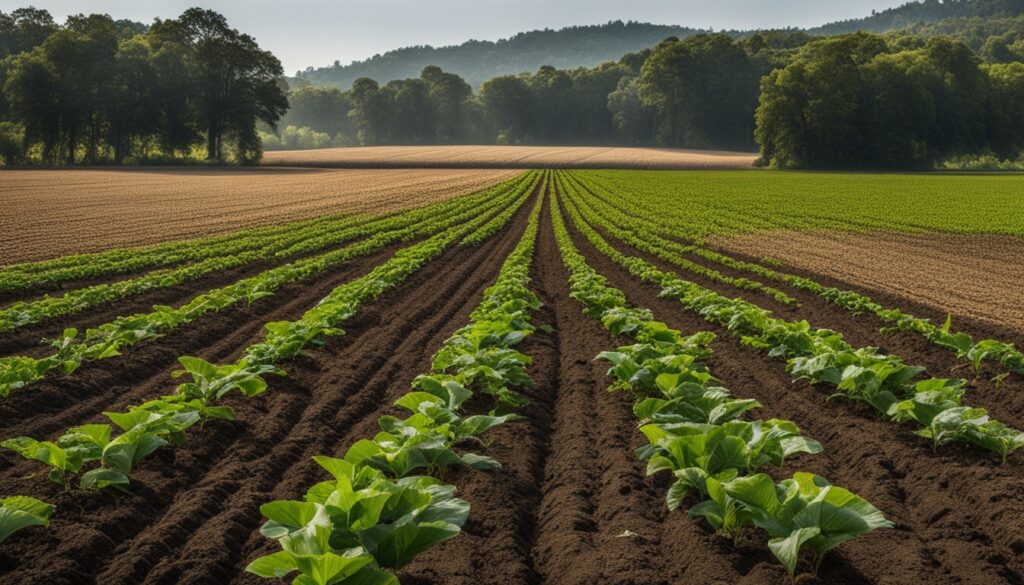
Critical to this are the farming rules in place. Current rules and help often lean towards using one plant and many chemicals, not variety. Changing these rules is key to helping farmers choose greener paths.
Selling to the world adds more pressure. Market bigwigs favour massive, similar crop beat-loads variety gives, making going green harder. This pushes sustainable farmers against the odds.
Our impact on nature is huge, covering 80-90% of liveable land. Around 1.1 billion people live where life thrives, showing how closely farm rules and green variety are linked.
| Factor | Impact | Data |
|---|---|---|
| Land Use | Significant ecological impacts | 30% of land used for crops/pastures |
| Livestock Grazing | Depletes wetlands and disrupts ecosystems | 10-20% of land used |
| Human Footprint | Major conversion of natural habitats | 80-90% of habitable lands affected |
Even with these hurdles, we must push on. Making farming fit better with nature’s needs is crucial for what’s ahead. This means using water, land, and other resources better, to balance making a living and protecting diversity.
Biodiversity brings big economic perks, both locally and globally. In the United States, this natural variety adds up to $319 billion every year. Across the world, the number is an astonishing $2,928 billion. These figures show the huge impact of biodiversity on our lives and economies.
There’s a real benefit to growing a variety of crops. Farms of a medium size see a boost when they grow different things. They find stable markets that value diversity and pay more for it. This move also meets the increasing demand for green products. So, it’s a win for farmers and the planet.
Farmers who boost biodiversity do well in today’s markets. They get extra help from government rules that protect nature. These rules often bring tax breaks or money help, supporting smart farming. Plus, avoiding too many chemicals through biodiversity helps save more money.
This blend of better crops and government help reflects great income from biodiversity. It steers farming towards more profit and planet care.
The role of perennial crops is crucial for our planet. They help make our agricultural systems better for the environment. Unlike yearly crops, they need less care, which is good news for the planet.
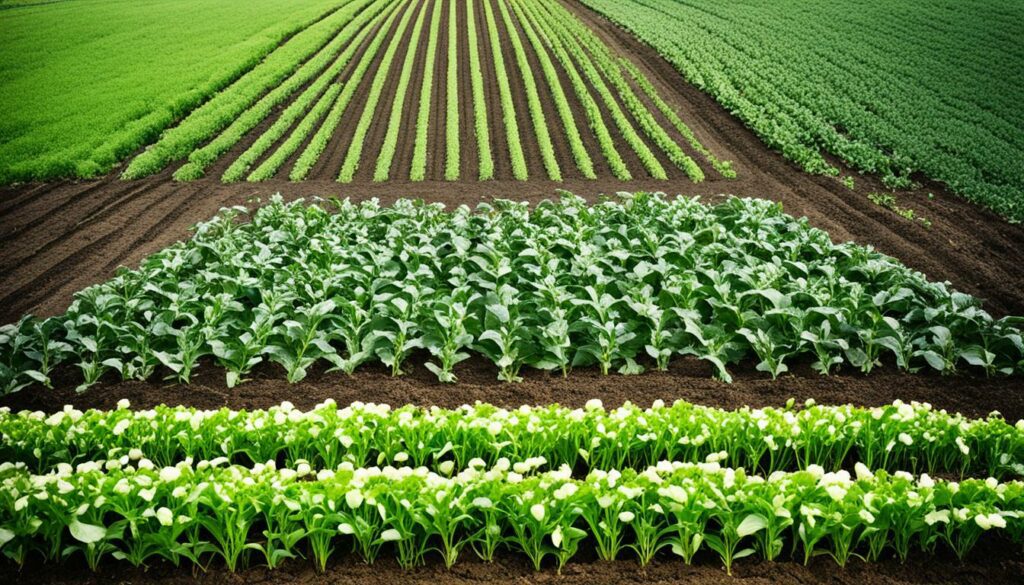
Encouraging farmers to grow perennial crops is vital. By supporting these crops, we encourage farmers to join in the effort to protect nature. This helps make our farmlands richer in plants and animals.
Perennial crops also help keep the soil healthy by not disrupting it often. For example, Kernza, a special wheatgrass, has deep roots. These roots do wonders for capturing carbon and keeping the soil full of life.
Having these crops around means more bugs, birds, and tiny creatures find homes. This adds up to a healthy balance in nature on the farms, which is good for growing food. It’s like a small ecosystem right there on the farm.
Studies show that forever-grains can be a big part of our farming future. Making them better and more wanted is a goal for many. After all, these plants are cheaper to look after and do a lot of good for the land.
But for these farming changes to happen, we need support from the top. Programs like the Kernza CAP can help get more of these special crops out there. They aim to make farms all around better and greener for everyone.
The future of farming depends on new ways of farming and using technology to solve major food issues. Loss of plants and animals threatens life on Earth. So, we are putting more effort into sustainable farming to help nature thrive and make our food systems strong.
A report by the World Economic Forum shows a big drop in animal populations since 1970. This decline, mostly in Latin America and the Caribbean, hurts farming and our environment a lot.
Using smart technology and data can make our farms better. These modern ways not only help more plants and animals to live but also make our soil more fertile. This means we can use fewer harmful chemicals to grow food.
New farming methods are key to a sustainable future. Changes like switching crops helps fight off pests naturally and makes the soil richer. This is great for nature and improves how well our food grows.
Other techniques, like making our own soil from plants or covering the ground with special plants, help friendly microorganisms in the soil. This boosts our food harvest and keeps the farm in balance with nature.
Technology plays a big part in making farming good for nature. With smart machines and computers, farmers can do the right thing for the land and the animals. They can check how healthy their crops are and what the soil needs. This helps them take care of their farm in the best way possible.
What’s more, a lot of the world’s economy depends on nature being healthy. As people understand more about why nature matters, we can protect it better.
| Biodiversity Statistic | Impact |
|---|---|
| 70% drop in vertebrate populations since 1970 | Reduces ecosystem resilience and agricultural productivity |
| 85% loss of wetlands | Impacts carbon absorption and climate regulation |
| Only 9 species account for 66% of crop production | Highlights the need for increased crop biodiversity |
| 41% of mammals to lose half their habitat with 3°C rise | Calls for urgent mitigation through sustainable farming |
We can move towards farming that keeps the planet healthy by using these new tools and ideas. This way, we ensure there’s plenty of food and nature for the future.
Mid-scale farms on California’s Central Coast show how diverse farming practices can be successful. These farms are usually between 20 and 350 acres. They’re just the right size to make the most of their resources. Our study looked at 80 organic lettuce farms. We spoke with 20 farmers, making up about 25% of the area’s lettuce producers. This gave us a deep look at how they farm and the issues they face.
We focused our interviews in Monterey, San Benito, Santa Cruz, and Santa Clara. Each area gave us a unique view of farming in mid-scale operations. These farms are better at using different farming methods than bigger or smaller ones. This helps them stay financially strong and keep the land healthy. They succeed because they have their own land, easy access to money, and buyers who pay more for eco-friendly produce.
Even though these farms make a lot of money together, they have to deal with some big environmental problems. The water and wildlife homes are getting worse. But, by farming in many different ways, they’re helping the soil and crops be healthier. Since 2016, the Healthy Soils Program has been giving them money to farm in ways that help the planet. This helps them move towards farming that’s good for nature and business.
Mid-scale farms can really help make farming more diverse and better for the environment. Learning about their different ways of farming shows us that special rules made just for their area could really help. All this study helped us see that different farm sizes have their own issues and roles. It’s clear that making smart policies can help this kind of farming a lot.
Biodiversity in crop management means using many different plants, animals, and tiny organisms together. This improves farm productivity, helps the environment, and makes farming more resilient.
Biodiversity helps farming last a long time by making the soil healthier. It also fights off pests as natural enemies of harmful bugs. This makes farms stronger and more productive in the long run.
Crop diversity is vital for many reasons. It helps farms have more life, like bees and good bugs. This makes the soil better and the food more nutritious. Overall, it helps farms work well with nature.
Cover crops are good for the soil. They make the land more fertile, stop it from washing away, and keep weeds down. This leads to better harvests and safer farming methods.
Composting improves the ground by adding nutrients and good bacteria. This makes the soil healthier and boosts crop growth, especially in environmentally-friendly farming systems.
Agroecosystems use natural farming methods to grow food. They help plants, animals, and the environment live together well. This leads to sustainable, productive farms.
Strategies for saving biodiversity in farms include saving particular species and their homes. They also focus on keeping important parts of nature that support many other plants and animals.
By using organic methods and promoting good soil life, farms can grow better crops. This includes recycling nutrients and making the soil richer, which means more food from the same land.
Biodiversity makes farms more able to deal with weather changes. It does this by making the land more fertile and by naturally protecting plants from pests. This helps farms face climate challenges better.
Government rules and projects like EQIP and Healthy Soils help farmers make more biodiverse farms. They provide money and advice. But sometimes, it’s hard for farmers to follow all the rules.
Farmers find it tough to be more diverse because of money, not owning their land, and needing to sell in the wrong kind of markets. This makes it hard to use more biodiversity.
Having many different crops can make farms more money by meeting what shoppers want. It also makes farms stronger against sickness and cuts down on expensive chemicals, saving money.
Perennial crops help farms last by keeping the soil good, stopping it from eroding, and always covering the ground. They also create homes for helpful animals, which is key for a healthy farm.
New farming ways like planting trees among crops, rotating what’s grown, and using technology help farms have more life. This makes farming better for the environment and for growing food.
Medium-sized farms can get a good balance by growing a variety of things. They sell well because they can offer special produce. It also helps that they’re big enough to reach many buyers.